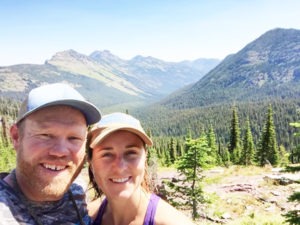
By Michael Howell
Last Saturday Land Tawney was presented with the prestigious Nick Kramis Conservation Award at the Ravalli County Fish and Wildlife Association’s annual banquet. Tawney was presented the award by Dale Burk on behalf of RCFWA President Tony Jones, who could not attend the ceremony.
Burk had guaranteed Tawney would be at the banquet by inviting him to be a guest speaker to talk about some of his current conservation work on the national level in Washington, D.C. But instead of introducing Tawney as a speaker, Burk surprised him, by calling him up to accept an award which he called one of the “highest” awards an individual can get for their efforts on behalf of conservation in the fields of wildlife and natural resource conservation here in the Bitterroot.
Burk noted that Tawney is a fifth generation Montanan whose first family member born in Montana was born in Stevensville. The family later established the Dowling Funeral Home in Hamilton. Land grew up visiting the family cabin on the East Fork of the Bitterroot, fishing for cutthroat trout and chasing the wily wapiti in the nearby mountains.
“Land’s father, Phil Tawney, one of my closest personal friends, by the way, helped create the Teller Wildlife Refuge and each summer there nowadays the annual Teller ‘n Tawney fundraiser is held to support the work of the Teller Refuge. Indeed, Land has strong roots in the Bitterroot,” said Burk. He said Tawney’s strong roots grew into a lifelong commitment to conserve wild public lands, waters and wildlife.
Land received a Bachelor of Science in 2000 from the University of Montana and shortly thereafter started volunteering for the fledgling Theodore Roosevelt Conservation Alliance (now Partnership). Volunteering grew into a part-time job, then full time job and ultimately he became their national grassroots organizer.
Burk said Tawney’s greatest accomplishment in this position was the establishment of the “open fields” provision of the Farm Bill, which has benefitted public access to private land programs across the U.S., including Montana’s block management program.
After 3½ years with TRCP, Land joined the National Wildlife Federation, of which the Montana Wildlife Federation is an affiliate and of which the Ravalli County Fish and Wildlife Association is an affiliate.
“Land’s role changed some over his 8½ years at NWF,” said Burk, “but ultimately he became their senior manager for sportsmen leadership.” He said Tawney’s greatest accomplishment was securing the largest ever single payout of $18.5 billion for the restoration of the Gulf Coast and the Mississippi River Delta after the Deepwater Horizon oil spill.
During his years at NWF, Land was also a founding member of Hellgate Hunters & Anglers in Missoula, where he served three terms as president. In addition, he helped form the Montana Sportsman Caucus and Advisory Council. Land also served three terms on the Private Land Public Wildlife Council, two terms as chairman.
In 2013, Land left the NWF and went to the fledgling Backcountry Hunters and Anglers as their second full-time employee and Executive Director, a volunteer organization focused on public land policy – making sure the public has access to public lands and waters and the fish and wildlife habitat found there. In his almost four years at the helm, BHA has grown exponentially. Based in Missoula, BHA now has members in all 50 states and one Canadian province, 14 full-time staff, and four contractors. Backcountry Hunters and Anglers has led the way nationally to keep public lands in public hands and most recently was the tip of the spear on forcing Congressman Jason Chaffetz to pull back his ill-advised effort to sell off 3.3 million acres of public lands in the West.
Since his father’s untimely passing 22 years ago, Land has served as vice president for the Phil Tawney Hunter Conservation Endowment, which has awarded over $70,000 worth of grants and scholarships in Montana to carry on his father’s conservation legacy.
Land told the Bitterroot Star that it was quite an honor, not only to get the Kramis Award, but to get it from one of the oldest and strongest conservation groups in the state. He said not only have they been around a long time, they have done a lot of great things. He mentioned the predator studies on the East Fork and West Fork of the Bitterroot where studies on the elk herds showed that wolves were not the main predator affecting elk populations, providing the information needed to manage the herds so that the elk population is now rising in the area.